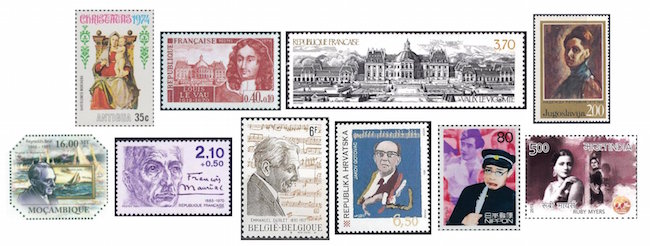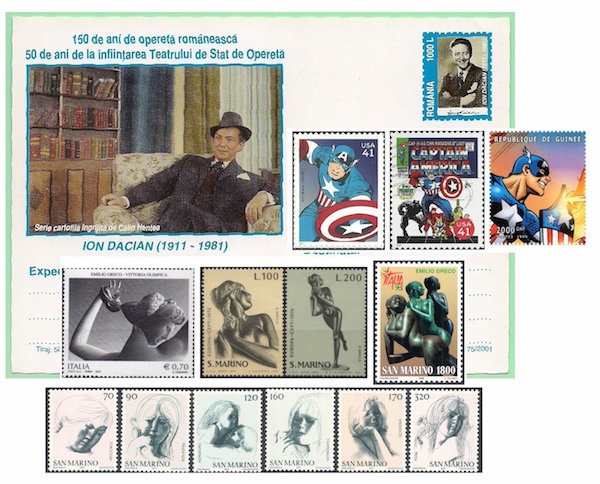The Arts on Stamps of the World —October 11
An Arts Fuse regular feature: the arts on stamps of the world.

By Doug Briscoe
As we have, in my estimation, at least, no titans to dominate the teeming October 11 birthday babies, we’ll let strict chronology hold sway in today’s presentation.
Actually, we begin, not with birthdays, but with two death date observances. Italian painter Bartolomeo Montagna (1450?– 11 October 1523) was born with the family name Cincani. He had a brother Baldissera, who was a goldsmith, and a son, Benedetto, who became an engraver. As for Bartolomeo himself, he was born near Brescia and was mostly active in Vicenza, concentrating on Madonnas. One of these we see on a 1974 Christmas stamp from Antigua.
French architect Louis Le Vau (1612 – 11 October 1670) worked for Louis XIV, most memorably on Vaux-le-Vicomte, Versailles, and the Louvre. His brother François was the architect of the Church of Saint-Louis-en-l’Île in Paris. When Nicolas Fouquet became superintendant of finances, he commissioned Le Vau, landscape architect André le Nôtre, and decorator Charles Le Brun to expand his small château at Vaux-le-Vicomte. It is this building that is shown in the background of the Le Vau stamp of 1970 and on the unusually wide stamp of 1989. Similarly, Le Vau was a major, but not the sole contributor to the redesigns of Versailles and the Palais du Louvre.
Our first birthday celebration is for the American painter Reynolds Beal (October 11, 1866 – December 18, 1951), born in New York City. Having shown artistic talent from an early age, he studied naval architecture at Cornell. Beal was active at the artist’s community in Noank, Connecticut in the first years of the century, though he also spent a year at sea working on a sketchbook, Cruising Aboard U.S.S. School Ship St. Mary’s, published in 1901. Beal was fond of painting beaches, circuses, and carnivals, but he was also a world traveler who captured scenes from such disparate locations as Singapore, China, Samoa, Egypt, Trinidad, and Haiti. For a time he lived in Gloucester in a studio overlooking Rockport’s Inner Harbor. He died in Rockport at the age of 85. His younger brother Gifford Beal was also a painter. The Mozambique stamp, one of a set of impressionist painters, gathers a rendering of the artist with two of his pieces: Early Morning (1922) and The Regatta at Marblehead (1924).
The important Serbian painter Nadežda Petrović was born on the 11th or 12th of October in 1873. She is held to be not only the most important woman painter of her time and place, but also the most famous of the country’s impressionist and fauvist artists. A woman of great intellectual curiosity, she attended a women’s college in Belgrade and subsequently became a teacher there before moving on to Munich in 1893. There she was powerfully struck by the work of Kandinsky, Klee, and others. Returning home in 1904, she took up residence at the family home of Resnik, which she captured in one of her best known works. In the first decade of the 20th century she exhibited in a number of European cities. Petrović selflessly curtailed her painting in 1912 so as to volunteer as a nurse during the Balkan Wars and again in World War I. During this period she contracted typhus and cholera while ministering to Serbian soldiers, succumbing to typhus on 3 April 1915. Besides the Self-Portrait stamp, she is honored on the Serbian 200 dinar banknote.

Another Nobel Prize winner enters the ranks. François Mauriac (11 October 1885 – 1 September 1970) was born in Bordeaux and studied there and in Paris. In a long and distinguished career he was a member of the Académie française from 1933, won the Nobel in Literature in 1952, and was awarded the Légion d’honneur in 1958. After the war he had a contretemps with Camus (in duelling newspaper columns) over whether collaborators should be vigorously sought out and punished (Camus) or bygones should be allowed to be bygones (Mauriac), with Mauriac arguing that justice could not be impartial with social wounds so fresh. Later, Mauriac also opposed the French presence in Vietnam and was an outspoken opponent of “enhanced” procedures (i.e., torture) in Algeria. He wrote novels, plays, criticism, poetry, journalism, memoirs, and a biography of de Gaulle.
Two European composers, the Belgian Emmanuel Durlet and the Croatian Jakov Gotovac (GO-to-vahts), share this October 11 birthday. Emmanuel Durlet (1893 – 7 February 1977) was primarily known as a pianist. In addition to study in his home country, he attended classes under Godowsky in Vienna. In 1918, over the course of two months, he gave recitals of all the Beethoven piano sonatas. He taught at the Antwerp Music Conservatory for 39 years, beginning in 1920. Apparently, he didn’t start composing until 1933, most of his output being for the piano, including in the main fifty solo pieces, a further eighty for beginners, and 300 arrangements of 18th-century Flemish harpsichord music. There is also a concerto (as well as one for violin). Some of his music, including his violin sonata, can be found on CDs from Brilliant and Koch/Schwann. In 1978, one of his pupils, Juliane Castro, founded the Prix International Emmanuel Durlet pour Piano.
Jakov Gotovac (1895 – 16 October 1982) conducted opera at the Croatian National Theatre from 1923 to 1958. His own comic opera Ero s onoga svijeta (Ero the Joker) was premièred at Zagreb in 1935, and is regarded as Croatia’s best-known opera. It has been performed around the world and translated into nine languages. Besides his works for the stage, there is also a body of orchestral, choral, and solo vocal music. CPO has issued an album of his symphonic poems.
A popular entertainer as a comedian and singer on the stage, on radio, and in films, Kenichi Enomoto (October 11, 1904 – January 7, 1970) was better known by his stage name Enoken. He made his stage debut at 18 in 1922 and started his own troupe in 1930. His approach brought innovation to the stage and had a significant influence in Tokyo leading up to World War II, with his reputation spreading to the national level after his appearance in the 1934 movie Enoken no Seishun Suikoden (Enoken’s Tale of Youth’s Folly). His succeeding films mostly used his stage name Enoken in the title (one thinks of the Madea series), and he even appeared in one of Akira Kurosawa’s films (The Men Who Tread on the Tiger’s Tail, 1945). His career came to an effective end when necrosis in his right leg necessitated amputation, but he made a stage comeback with a prosthetic leg in 1963.
I just discovered that I missed a birthday a few days back, and thought I may as well add Ruby Myers (8 October 1907 – 10 October 1983) to the present article. She was one of the earliest Eurasian female silent film stars in Indian cinema. Of Baghdadi Jewish heritage, she was better known by her stage name Sulochana. Myers was discovered by filmmaker Mohan Bhavnani while working as a telephone operator. Before long she was the highest paid movie star in India, with a series of hits in the late 1920s. The introduction of sound presented a bit of a problem, not because of Sulochana’s voice but as a consequence of her lack of familiarity with Hindustani. She took a year off to learn the language and made a grand comeback. From 1933 to 1939 she was partnered by another of the great stars of the day, D. Billimoria. But, as with Norma Desmond, the pictures got small, and despite winning India’s most prestigious film award, the Dada Saheb Phalke Award, for life achievement in 1973, she died in obscurity in a modest flat two days after her 76th birthday.

Romanian operetta tenor Ion Dacian (1911 – 8 December 1981) was born Ion Pulcă 106 years ago today. He was associated mostly with operetta, singing in Johann Strauss, Lehár, Carl Zeller, Paul Lincke, and the like. He began his career with the Romanian Opera in Cluj in 1934. In 1950 he was named first soloist of the State Operetta Theater and became its director in 1963. Subsequently (1971) he was dismissed with no reason given. Dacian performed 57 roles and gave 5000 performances. In the year 2000 the National Operetta Theater was renamed for him. The postal card dates from 2001.
It’s also the birthday of American comic book writer Joe Simon (born Hymie Simon; October 11, 1913 – December 14, 2011). He was a creator or co-creator of many characters during the Golden Age of Comics in the 1930s and 40s, most memorably Captain America, in collaboration with artist Jack Kirby. (I particularly regret another omission, as Kirby’s centenary just passed on August 28th. He died in 1974.) Simon and Kirby also joined forces on Timely Comics, which metamorphosed into Marvel. Simon, himself an artist as well as a publisher and editor, was also the founder of Sick magazine (a sort of Mad manqué) in 1960, which printed its final issue in 1980. Two US Captain America stamps are joined by one from Guinea.
The Italian sculptor Emilio Greco (11 October 1913 – 5 April 1995) was born in Catania, Sicily and relocated to Rome. He was drafted into the Italian army during World War II and served in Albania. Although he exhibited as early as 1943, his first solo shows were at the Palazzo Barberini in 1958 and in Munich in 1959. Greco has created numerous monumental bronzes that are situated around the world. His Olympic Victory appears on a centenary stamp from Italy; all the rest come from San Marino, including a set of six called “The Civil Virtues Sketches”. What exactly this is (designs for a series of sculptures? independent drawings?) my endless googling does not inform me.
One of the progenitors of the English sonnet, Sir Thomas Wyatt, born in 1503, died on this date in 1542. No stamp.
A graduate of the University of Massachusetts with a B.A. in English, Doug Briscoe worked in Boston classical music radio, at WCRB, WGBH, and WBUR, for about 25 years, beginning in 1977. He has the curious distinction of having succeeded Robert J. Lurtsema twice, first as host of WGBH’s weekday morning classical music program in 1993, then as host of the weekend program when Robert J.’s health failed in 2000. Doug also wrote liner notes for several of the late Gunther Schuller’s GM Recordings releases as well as program notes for the Boston Classical Orchestra. For the past few years he’s been posting a Facebook “blog” of classical music on stamps of the world, which has now been expanded to encompass all the arts for The Arts Fuse.
